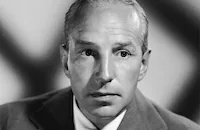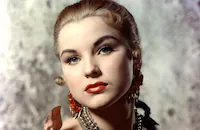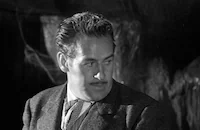The Last Hunt

Brief Synopsis
Cast & Crew
Richard Brooks
Robert Taylor
Stewart Granger
Lloyd Nolan
Debra Paget
Russ Tamblyn
Film Details
Technical Specs

Synopsis
When a huge buffalo herd charges directly through his Dakota grazing lands, Sandy McKenzie can only watch helplessly as all of his cattle are killed in the stampede. Buffalo hunter Charles Gilson asks Sandy to join him in hunting buffalo, but Sandy, an ex-buffalo hunter who had abandoned the trade after growing weary of all the killing, is anything but eager to return to that line of work. Charley, a dark and volatile character, remarks that killing, as he learned during the war, is both natural and pleasurable. Realizing he has little choice, Sandy finally agrees to become Charley's partner, and in town, he hires two men to round out the party: Jimmy O'Brien, a red-headed "half-breed" who has decided to leave the reservation and live as a white man, and Woodfoot, a peg-legged alcoholic who once was known as the best mule skinner in the territory. Before the men depart, however, their mules are stolen. Charley pursues and kills the Sioux thief and his companion, then takes a beautiful woman who was with the men and her infant son back to camp, where he orders her to prepare a meal and later kisses her roughly. On the following day, Charley locates a herd of grazing buffalo and, from his position on the nearby hill, shoots until the meadow is filled with carcasses. Sandy kills even more of the magnificent beasts, but he spares a white buffalo because the animal is sacred to the Sioux. Charley, however, nonchalantly kills the beast, and when the Sioux woman sees the slaughter, she bitterly declares, "You take away our food and now you kill our religion." Unperturbed, Charley leads the woman into his shack for the night, upsetting Sandy, who loves her. The next day, Jimmy's friend Spotted Hand offers to trade his horses for the buffalo hide, but Charley refuses and then challenges the young man to a gun battle. Spotted Hand is killed, and that night, the woman secretly gives Jimmy the sacred hide. At some distance from the camp, Jimmy uses the hide in a burial ritual for his friend. Later, Sandy asks why the woman remains with Charley, and she replies that because her people are starving, she must do whatever is required to keep the child alive. Feeling jealous of Charley and guilty at his own role in the killing of the buffalo, Sandy rides into town to sell the hides. He then gets drunk and starts a fight in the saloon, and later he inadvertently insults Peg, the dance hall girl, by suggesting that she is part Indian. Upon his return to camp, Sandy tells Woodfoot of his intention to free the Sioux woman. Several days pass, but few buffalo appear. Driven half-crazy by his desire to kill more animals, Charley mistakes the sounds of a passing thunderstorm for pounding buffalo hooves and sets out in pursuit of his prey. That night, Woodfoot gets Charley so drunk that Sandy is able to ride quietly away with the woman, but when daylight comes, Charley goes after them in a rage. Woodfoot drives Charley's horse away, an act that prompts Charley to kill him. After arriving at the reservation, Sandy learns that the Army never delivered a promised shipment of food and supplies to the Indians who live there. He and the Sioux woman ride to town for the supplies just as bitterly cold weather sets in. In town, Charley nearly kills Jimmy for refusing to speak ill of Sandy, and soon afterward, Jimmy sees Sandy and warns him of Charley's presence. Sandy, Jimmy and the woman drive a supply-laden wagon and a small herd of cattle back toward the reservation. The cold drives them into a cave for the night, but Charley arrives and shouts that when morning comes, he will kill them. The blizzard worsens, and Charley kills a buffalo and wraps himself in the hide for warmth. In the morning, however, Sandy emerges from the cave to find that Charley has frozen to death.

Director

Richard Brooks
Cast

Robert Taylor

Stewart Granger

Lloyd Nolan

Debra Paget

Russ Tamblyn
Constance Ford
Joe Desantis
Ainslie Pryor
Ralph Moody
Fred Graham
Ed Lonehill
Terry Wilson

Dan White
Jerry Martin
Steve Darrell
Joe Slim Balch

Roy Barcroft
William "bill" Phillips
Dick Rich
Casey Macgregor
Rosemary Johnston
Gerald Millard
Crew
Daniele Amfitheatrof
Richard Brooks
Joe De Yong
Ralph George
Cedric Gibbons
Charles K. Hagedon
Russell Harlan
Harold Humbrock
Al Kelley
Lowell Kinsall
Ben Lewis
Fred Maclean
David Humphreys Miller
David Humphreys Miller
Dr. Wesley C. Miller
Warren Newcombe
Merrill Pye
Robert Saunders
Dore Schary
William Tuttle
Edwin B. Willis

Film Details
Technical Specs

Articles
The Last Hunt
The character he plays, Charlie Gilson, is a sadistic man who enjoys killing (to such a degree that one character in the story likens it to sexual ecstasy). He teams with a fellow buffalo hunter, a far more sympathetic character played by Stewart Granger, and the two men immediately clash, especially when it becomes apparent that Taylor's character gets a kick out of slaughtering bison AND people, especially defenseless Indians he accuses of stealing his horses. The conflict leads to a final showdown in which Taylor stalks Granger during a harsh winter storm.
The Last Hunt was filmed on location in Custer National Park in the Black Hills of South Dakota, beautifully rendered by cinematographer Russell Harlan, who was responsible for the authentic, sweeping vision of dozens of Westerns, among them Red River (1948), The Big Sky (1952) and Rio Bravo (1959), all of them for Howard Hawks, the director with whom he worked most frequently. This film was directed by Richard Brooks, who is better known for such dark contemporary dramas as Blackboard Jungle (1955), In Cold Blood (1967) and Looking for Mr. Goodbar (1977) and for his controversial rewriting of Tennessee Williams in the screen adaptations of Cat on a Hot Tin Roof (1958) and Sweet Bird of Youth (1962).
The buffalo slaughter in the film is real; the protected animals were rapidly increasing in number and every year park wardens culled the herds to keep the amount of buffalo in line with available grazing land. At the time of production, it was standard practice to charge hunters a sizeable fee to come into the national park and shoot 50 or so of the animals. The hunting was intercut with shots of the stars shooting, although they did not take part in the actual killing. In fact in his autobiography, Granger said he and the crew were rather sickened by the whole thing, especially because the film required that the corpses be on hand for a number of days to complete necessary sequences. Since the extreme heat of the Black Hills location caused the bodies to decompose rapidly, the dead animals were loaded into refrigerated trucks each evening then dumped back onto the ground the following morning. Granger does not mention Taylor's reaction to this but notes how Brooks "seemed to revel in taking close shots of maggots crawling out of the corpses littering the plains or of the skinning and butchering of the stinking animals that had been shot days before."
The most difficult part of the shoot, however, was the final sequence, which was supposed to take place in the dead of winter. Obviously, production couldn't be shut down for several months until the weather changed, so the actors had to film their scenes in nearly 120 degrees dressed in heavy clothes and scarves, drinking gallons of water to keep from dehydrating as the sweat poured off them in buckets. Granger passed out twice and had to have the clothes ripped off him. The surrounding hills were sprayed in white powder to give the impression of snow, and airplane engines were used to create gale winds, filled with gypsum to simulate a blizzard.
Anne Bancroft, then a relatively unknown young actress, was originally cast in the role of the Indian Girl eventually played by Debra Paget. Very early on in production, a scene was filmed in which Granger was supposed to sweep the girl into his saddle and ride off. At the crucial moment, the horse bucked and Bancroft landed painfully hard on the saddle pummel. Her lawyers sued MGM and got her long-term contract cancelled as part of the settlement. Granger jokingly said he was responsible for freeing her from a career of playing thankless roles as Indian girls for MGM.
During the shoot, the British-born Granger became attracted to the idea of life in the open air of the American West, especially since he and then-wife Jean Simmons were starting a family and not wanting to raise their children in a Hollywood setting. Granger befriended one of the wranglers hired as extras and advisers, Elmer Black, who helped the British actor master a Western drawl. After filming was completed, Black also helped Granger find a suitable ranch property in the area.
Director: Richard Brooks
Producer: Dore Schary
Screenplay: Richard Brooks, based on the novel by Milton Lott
Cinematography: Russell Harlan
Editing: Ben Lewis
Art Direction: Merrill Pye, Cedric Gibbons
Original Music: Daniele Amfitheatrof
Cast: Robert Taylor (Charlie Gilson), Stewart Granger (Sandy McKenzie), Lloyd Nolan (Woodfoot), Debra Paget (Indian Girl), Russ Tamblyn (Jimmy O'Brien).
C-104m. Letterboxed. Closed captioning.
by Rob Nixon.

The Last Hunt
Quotes
Mr. Woodfoot, how come Charley hates Indians so much?- Jimmy
Now that's a good question, my boy. It's kinda funny, you know? Charley beats his horse, just like an Indian. Charley's free with his women, just like an Indian. Charley even blows his nose on his fingers, just like an Indian. I just don't get it.- Woodfoot
Trivia
Notes
The film's opening credits include the following written acknowledgment: "The M-G-M Studio is grateful to the officials of Custer State Park, the U.S. National Monument at Badlands and to Governor Joe Foss of South Dakota for their full-hearted cooperation in the making of this film. The area in which this picture was filmed maintains the largest buffalo herd in America. An annual thinning of the herd is required. We were permitted to photograph this necessary process. The shooting of the buffalo is the assignment of expert government riflemen who worked with us in the filming of the picture."
According to information in the file on the film in the MPAA/PCA Collection at the AMPAS Library, despite the above explanation, the Humane Society received some letters protesting the film's buffalo slaughtering scene. Rutherford T. Phillips, the executive director of the Los Angeles chapter of the SPCA, responded to the complaints by saying that the slain buffalo had been earmarked for destruction because of their physical condition and were killed by a single gunshot fired by expert marksmen. Reviewers also commented on the brutality of the slaughter scene. The New York Times review described the scene as "startling and slightly nauseating," but added that it was dramatically necessary because the film "aimed to display the low and demoralizing influence of a lust for slaughter upon the nature of man." In addition to the above-acknowledgment, the film includes a written foreword, stating that, due to reckless slaughter "by hunters and Indians," the number of buffalo in America had been reduced from sixty million in the 1850s, to 3,000 in the 1880s, and 500 by 1900. According to modern historical sources, conservation efforts in the second half of the twentieth century has increased the number of buffalo in North America to more than 200,000.
MPAA/PCA records also indicate that in mid-May 1955, the PCA pressured producer Dore Schary and writer/director Richard Brooks to remove any suggestion that "Charley" rapes the Indian woman, a plot element apparently included in late drafts of the script. An Hollywood Reporter news item on June 8, 1955 stated that actress Liliane Montevecchi was cast as the film's female lead but she was not in the film. Although Hollywood Reporter production charts include Anne Bancroft in the cast, according to news items, illness forced her out of the production. Bancroft was replaced by Debra Paget, who was borrowed from Twentieth Century-Fox for the picture. According to a studio pressbook contained at the AMPAS Library, Joe De Yong, a painter and expert on early western life, designed the hunter and Indian costumes for the film. The pressbook also notes that Gerald Millard, a two-year-old Native American, was reportedly found by Brooks on the Rosebud Sioux Indian Reservation and cast in the picture, as were descendants of Sitting Bull and his followers, who were discovered on the Rapid City and Pine Ridge Reservations. Les Price, the superintendent of Custer State Park, helped organize the location filming, according to the pressbook.
As noted in Hollywood Reporter news items, the film was shot on location in South Dakota. A June 1955 Hollywood Reporter news item announced that filming would take place at five locations in the Black Hills and one in the Badlands. Four cameras were used to shoot the buffalo stampede, which employed 1,000 animals herded by a flotilla of jeeps and wranglers, according to the pressbook. A July 12, 1955 Hollywood Reporter news item noted that David Humphreys Miller, who was hired as a contributing writer for the film would also serve as a technical advisor, dialogue coach and translator for the Sioux Tribe. The news item also stated that he would paint some of the oil sketches used as publicity for the film.

Miscellaneous Notes
Released in United States Winter February 1956
CinemaScope
Released in United States Winter February 1956















